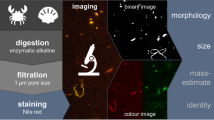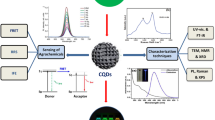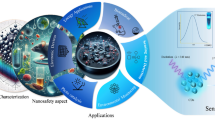Abstract
Although some ratiometric fluorescent sensors have been reported to detect tetracyclines, most of ratiometric fluorescent sensors were established based on europium ion with a narrow linear range. In this work, a ratiometric fluorescent sensor for tetracyclines detection was established based on the dual-emission lanthanum-doped carbon dots (La-CDs) as probes combining with the characteristic pH-response of tetracyclines. The fluorescence intensity of tetracyclines will be enhanced in high pH, and the emission peak of tetracyclines overlapped with the peak of probes. The superposition effect of tetracyclines and probes at 515 nm greatly improved the sensitivity of the ratiometric fluorescent sensor and widened the detection range, and linear ranges for oxytetracycline (OTC) and tetracycline (TC) were respectively 0.00–805.20 μM and 0.00–1039.50 μM. Moreover, the preparation procedure of the La-CDs was simple and time saving and the coupling agent was not required. A comparison of La-CDs with undoped carbon dots (un-CDs) showed that the optical performance and sensing performance of La-CDs were improved. In addition, a portable paper sensor with La-CDs as probes was preliminarily explored in this work, and the sensor has been applied to detect OTC and TC in pork and fish with satisfactory results.
Graphical abstract








Similar content being viewed by others
References
Li RX, Wang WJ, El-Sayed E-SM, Su KZ, He PL, Yuan DQ. Ratiometric fluorescence detection of tetracycline antibiotic based on a polynuclear lanthanide metal–organic framework. Sensor Actuat B: Chem. 2021;330:129314.
Sreejith S, Shajahan S, Prathiush PR, Anjana VM, Viswanathan A, Chandran V, et al. Healthy broilers disseminate antibiotic resistance in response to tetracycline input in feed concentrates. Microb Pathogensis. 2020;149:104562.
Wei W, He J, Wang YY, Kong MJ. Ratiometric method based on silicon nanodots and Eu(3+) system for highly-sensitive detection of tetracyclines. Talanta. 2019;204:491–8.
Li YY, Du QQ, Zhang XD, Huang YM. Ratiometric detection of tetracycline based on gold nanocluster enhanced Eu(3+) fluorescence. Talanta. 2020;206:120202.
Li L, Shi LH, Jia J, Eltayeb O, Lu WJ, Tang YH, et al. Red fluorescent carbon dots for tetracycline antibiotics and pH discrimination from aggregation-induced emission mechanism. Sensor Actuat B: Chem. 2021;332:129513.
Xu J, Shen XK, Jia L, Zhou TL, Ma TL, Xu ZQ, et al. A novel visual ratiometric fluorescent sensing platform for highly-sensitive visual detection of tetracyclines by a lanthanide- functionalized palygorskite nanomaterial. J Hazard Mater. 2018;342:158–65.
Han S, Yang L, Wen ZG, Chu SY, Wang M, Wang ZY, et al. A dual-response ratiometric fluorescent sensor by europium-doped CdTe quantum dots for visual and colorimetric detection of tetracycline. J Hazard Mater. 2020;398:122894.
Wu ZT, Zhou Y, Huang HY, Su Z, Chen SM, Rong MC. BCNO QDs and ROS synergistic oxidation effect on fluorescence enhancement sensing of tetracycline. Sensor Actuat B: Chem. 2021;332:129530.
Perez-Rodriguez M, Pellerano RG, Pezza L, Pezza HR. An overview of the main foodstuff sample preparation technologies for tetracycline residue determination. Talanta. 2018;182:1–21.
Aguilera-Luiz MM, Vidal JL, Romero-Gonzalez R, Frenich AG. Multi-residue determination of veterinary drugs in milk by ultra-high-pressure liquid chromatography-tandem mass spectrometry. J Chromatogr A. 2008;1205(1–2):10–6.
Feng MX, Wang GN, Yang K, Liu HZ, Wang JP. Molecularly imprinted polymer-high performance liquid chromatography for the determination of tetracycline drugs in animal derived foods. Food Control. 2016;69:171–6.
Ibarra IS, Rodriguez JA, Miranda JM, Vega M, Barrado E. Magnetic solid phase extraction based on phenyl silica adsorbent for the determination of tetracyclines in milk samples by capillary electrophoresis. J Chromatogr A. 2011;1218(16):2196–202.
Tang Y, Huang XH, Wang XL, Wang CX, Tao H, Wu YG. G-quadruplex DNAzyme as peroxidase mimetic in a colorimetric biosensor for ultrasensitive and selective detection of trace tetracyclines in foods. Food Chem. 2021;366:130560.
Diana S. Aga RGaPK. Application of ELISA in determining the fate of tetracyclines in land-applied livestock wastes. Analyst. 2003;128:658–62.
Ahmed SR, Kumar S, Ortega GA, Srinivasan S, Rajabzadeh AR. Target specific aptamer-induced self-assembly of fluorescent graphene quantum dots on palladium nanoparticles for sensitive detection of tetracycline in raw milk. Food Chem. 2021;346:128893.
Wang S, Dong YY, Liang X. Development of a SPR aptasensor containing oriented aptamer for direct capture and detection of tetracycline in multiple honey samples. Biosens Bioelectron. 2018;109:1–7.
Zhang L, Wang JP, Deng JK, Wang S. A novel fluorescent “turn-on” aptasensor based on nitrogen-doped graphene quantum dots and hexagonal cobalt oxyhydroxide nanoflakes to detect tetracycline. Anal Bioanal Chem. 2020;412(6):1343–51.
Wang G, Zhang HC, Liu J, Wang JP. A receptor-based chemiluminescence enzyme linked immunosorbent assay for determination of tetracyclines in milk. Anal Biochem. 2019;564–565:40–6.
Jin L, Qiao JT, Chen JH, Xu N, Wu MS. Combination of area controllable sensing surface and bipolar electrode-electrochemiluminescence approach for the detection of tetracycline. Talanta. 2020;208:120404.
Taghdisi SM, Danesh NM, Ramezani M, Abnous K. A novel M-shape electrochemical aptasensor for ultrasensitive detection of tetracyclines. Biosens Bioelectron. 2016;85:509–14.
Zhang L, Wang YL, Jia L, Bi N, Bie HY, Chen XZ, et al. Ultrasensitive and visual detection of tetracycline based on dual-recognition units constructed multicolor fluorescent nano-probe. J Hazard Mater. 2021;409:124935.
Jia P, Bu T, Sun XY, Liu YG, Liu JH, Wang QZ, et al. A sensitive and selective approach for detection of tetracyclines using fluorescent molybdenum disulfide nanoplates. Food Chem. 2019;297:124969.
Xiong J, Yang L, Gao LX, Zhu PP, Chen Q, Tan KJ. A highly fluorescent lanthanide metal-organic framework as dual-mode visual sensor for berberine hydrochloride and tetracycline. Anal Bioanal Chem. 2019;411(23):5963–73.
Khataee A, Jalili R, Dastborhan M, Karimi A, Ebadi Fard Azar A. Ratiometric visual detection of tetracycline residues in milk by framework-enhanced fluorescence of gold and copper nanoclusters. Spectrochim Acta A. 2020;242:118715.
Fu Q, Long CC, Qin LF, Jiang ZX, Qing TP, Zhang P, et al. Fluorescent and colorimetric dual-mode detection of tetracycline in wastewater based on heteroatoms-doped reduced state carbon dots. Environ Pollut. 2021;283:117109.
Zhao CX, Jiao Y, Gao Z, Yang YL, Li H. N, S co-doped carbon dots for temperature probe and the detection of tetracycline based on the inner filter effect. J Photoch Photobio A. 2018;367:137–44.
Wu L, Long R, Li T, Tang C, Tong X, Guo Y, et al. One-pot fabrication of dual-emission and single-emission biomass carbon dots for Cu(2+) and tetracycline sensing and multicolor cellular imaging. Anal Bioanal Chem. 2020;412(27):7481–9.
Guo JH, Lu WJ, Zhang HL, Meng YT, Du FF, Shuang SM, et al. Copper doped carbon dots as the multi-functional fluorescent sensing platform for tetracyclines and pH. Sensor Actuat B: Chem. 2021;330:129360.
Ma YS, Cen Y, Sohail M, Xu GH, Wei FD, Shi ML, et al. A ratiometric fluorescence universal platform based on N, Cu codoped carbon dots to detect metabolites participating in H2O2-generation reactions. ACS Appl Mater Inter. 2017;9(38):33011–9.
Zhang M, Wang WT, Zhang J, Zhou NL. Synthesis of lanthanum doped carbon dots for detection of mercury ion, multi-color imaging of cells and tissue, and bacteriostasis. Chem Eng J. 2017;330:1137–47.
Xu Q, Su RG, Chen YS, Theruvakkattil Sreenivasan S, Li N, Zheng XS, et al. Metal charge transfer doped carbon dots with reversibly switchable, ultra-High quantum yield photoluminescence. ACS Applied Nano Mater. 2018;1(4):1886–93.
Tejwan N, Saini AK, Sharma A, Singh TA, Kumar N, Das J. Metal-doped and hybrid carbon dots: a comprehensive review on their synthesis and biomedical applications. J Control Release. 2021;330:132–50.
Wang YH, Zhang C, Chen XC, Yang B, Yang L, Jiang CL, et al. Ratiometric fluorescent paper sensor utilizing hybrid carbon dots-quantum dots for the visual determination of copper ions. Nanoscale. 2016;8(11):5977–84.
Li XT, Fan KM, Yang RM, Du XX, Qu BH, Miao XM, et al. A long lifetime ratiometrically luminescent tetracycline nanoprobe based on Ir(III) complex-doped and Eu(3+)-functionalized silicon nanoparticles. J Hazard Mater. 2020;386:121929.
Ti MR, Li YS, Li ZQ, Zhao DX, Wu L, Yuan LF, et al. A ratiometric nanoprobe based on carboxylated graphitic carbon nitride nanosheets and Eu(3+) for the detection of tetracyclines. Analyst. 2021;146(3):1065–73.
Wu WJ, Zhao Q, Zhou R, Liang YC, Zhao WB, Shan CX. Ratiometric fluorescence sensor based on europium-grafted ZnO quantum dots for visual and colorimetric detection of tetracycline. Spectrochim Acta A. 2021;259:119901.
Li MT, Zhu NW, Zhu W, Zhang SH, Li F, Wu PX, et al. Enhanced emission and higher stability ovalbumin-stabilized gold nanoclusters (OVA-AuNCs) modified by polyethyleneimine for the fluorescence detection of tetracyclines. Microchem J. 2021;169:106560.
Li CL, Zeng CH, Chen Z, Jiang YF, Yao H, Yang YY, et al. Luminescent lanthanide metal-organic framework test strip for immediate detection of tetracycline antibiotics in water. J Hazard Mater. 2020;384:121498.
Zhang HQ, Huang YH, Lin XH, Lu FF, Zhang ZS, Hu ZB. Lanthanum loaded graphitic carbon nitride nanosheets for highly sensitive and selective fluorescent detection of iron ions. Sensor Actuat B: Chem. 2018;255:2218–22.
Yang SH, Sun XH, Wang ZY, Wang XY, Guo GS, Pu QS. Anomalous enhancement of fluorescence of carbon dots through lanthanum doping and potential application in intracellular imaging of ferric ion. Nano Res. 2018;11(3):1369–78.
Lin BX, Zhang TY, Xin XL, Wu D, Huang Y, Liu YW, et al. Europium(III) modified silicone nanoparticles for ultrasensitive visual determination of tetracyclines by employing a fluorescence color switch. Microchim Acta. 2019;186(7):442.
Xing XJ, Huang L, Zhao SJ, Xiao JF, Lan MH. S,N-Doped carbon dots for tetracyclines sensing with a fluorometric spectral response. Microchem J. 2020;157.
Liu SG, Liu T, Li N, Geng S, Lei JL, Li NB, et al. Polyethylenimine-derived fluorescent nonconjugated polymer dots with reversible dual-signal pH response and logic gate operation. J of Phys Chem C. 2017;121(12):6874–83.
Han L, Liu SG, Zhang XF, Tao BX, Li NB, Luo HQ. A sensitive polymer dots-manganese dioxide fluorescent nanosensor for “turn-on” detection of glutathione in human serum. Sensor Actuat B: Chem. 2018;258:25–31.
Yang Y, Wei QY, Zou T, Kong YL, Su LF, Ma D, et al. Dual-emission ratiometric fluorescent detection of dinotefuran based on sulfur-doped carbon quantum dots and copper nanocluster hybrid. Sensor Actuat B: Chem. 2020;321:128534.
Zhang X, Tan XY, Hu YP. Blue/yellow emissive carbon dots coupled with curcumin: a hybrid sensor toward fluorescence turn-on detection of fluoride ion. J Hazard Mater. 2021;411:125184.
Dong JX, Gao ZF, Zhang Y, Li BL, Zhang W, Lei JL, et al. The pH-switchable agglomeration and dispersion behavior of fluorescent Ag nanoclusters and its applications in urea and glucose biosensing. NPG Asia Mater. 2016;8(12):e335-e.
Lin M, Zou HY, Yang T, Liu ZX, Liu H, Huang CZ. An inner filter effect based sensor of tetracycline hydrochloride as developed by loading photoluminescent carbon nanodots in the electrospun nanofibers. Nanoscale. 2016;8(5):2999–3007.
Yan FY, Sun ZH, Pang JP, Jiang YX, Zheng WX. Functionalized carbon dots of thiazole derivatives based on inner filter effect for tetracyclines detection. Dyes Pigments. 2020;183:108673.
Zhang Y, Lv M, Gao PF, Zhang GM, Shi LH, Yuan MJ, et al. The synthesis of high bright silver nanoclusters with aggregation-induced emission for detection of tetracycline. Sensor Actuat B: Chem. 2021;326:129009.
Han L, Fan YZ, Qing M, Liu SG, Yang YZ, Li NB, et al. Smartphones and test paper-assisted ratiometric fluorescent sensors for semi-quantitative and visual assay of tetracycline based on the target-induced synergistic effect of antenna effect and inner filter effect. ACS Appl Mater Interfaces. 2020;12(41):47099–107.
Acknowledgements
This work was financially supported by the Natural Science Foundation of Hebei Province (Nos. B2019201397, B2015201193), the Project funded by China Postdoctoral Science Foundation (No. 2020M670678), the Foundation for Central Government Guidance for Local Science and Technology Development of Hebei Province (No. 216Z2605G), the Science and Technology Research Project of Hebei Higher Education (No. QN2016087), the Advanced Talents Incubation Program of Hebei University (No. 521000981136), Research Innovation Team of College of Chemistry and Environmental Science of Hebei University (No. hxkytd-py2101).
Author information
Authors and Affiliations
Corresponding authors
Ethics declarations
Conflict of interest
The authors declare no competing interests.
Additional information
Publisher's note
Springer Nature remains neutral with regard to jurisdictional claims in published maps and institutional affiliations.
Supplementary Information
Below is the link to the electronic supplementary material.
Rights and permissions
About this article
Cite this article
Fan, Y.J., Su, M., Shi, YE. et al. A ratiometric fluorescent sensor for tetracyclines detection in meat based on pH-dependence of targets with lanthanum-doped carbon dots as probes. Anal Bioanal Chem 414, 2597–2606 (2022). https://doi.org/10.1007/s00216-022-03895-x
Received:
Revised:
Accepted:
Published:
Issue Date:
DOI: https://doi.org/10.1007/s00216-022-03895-x




